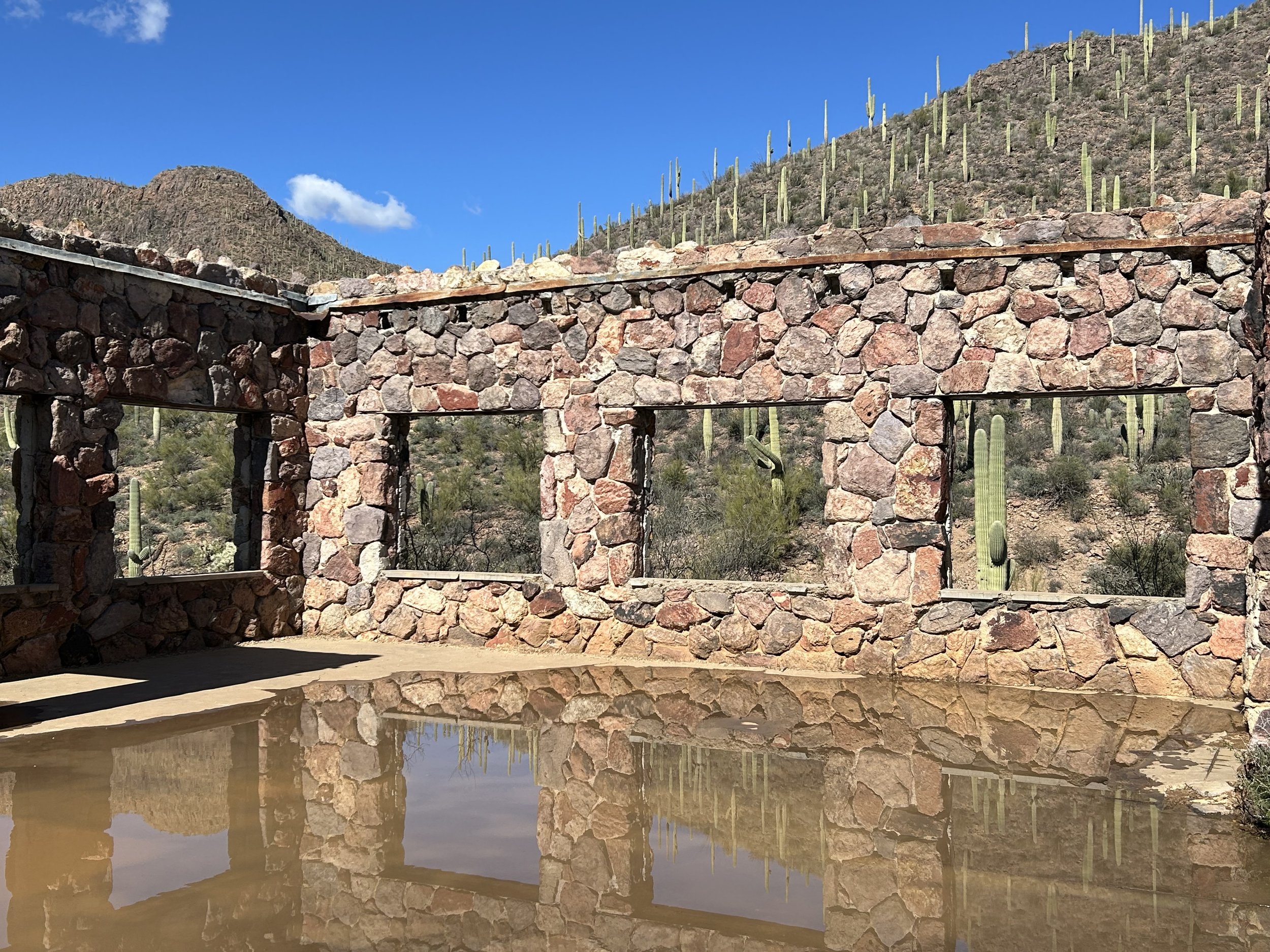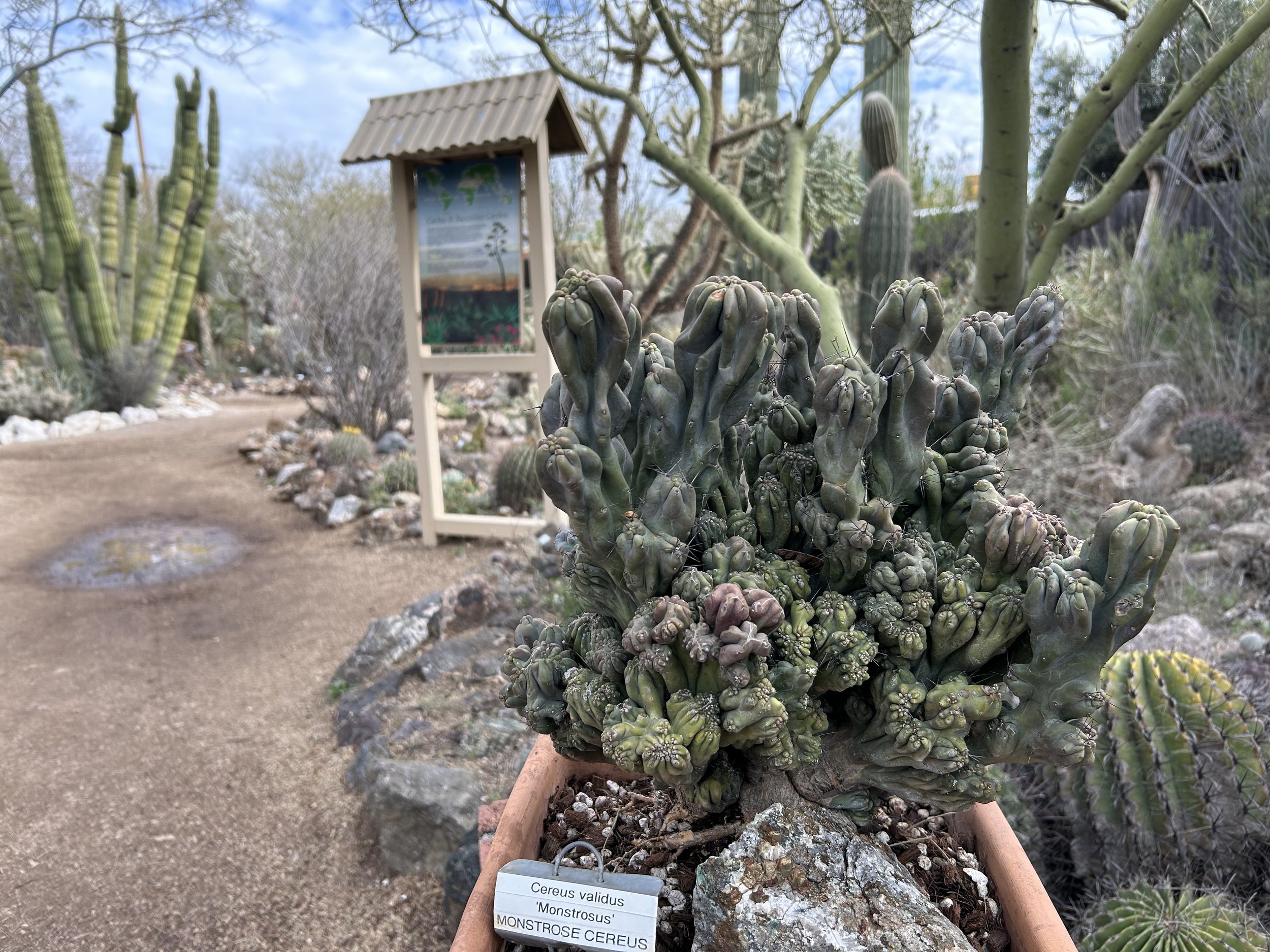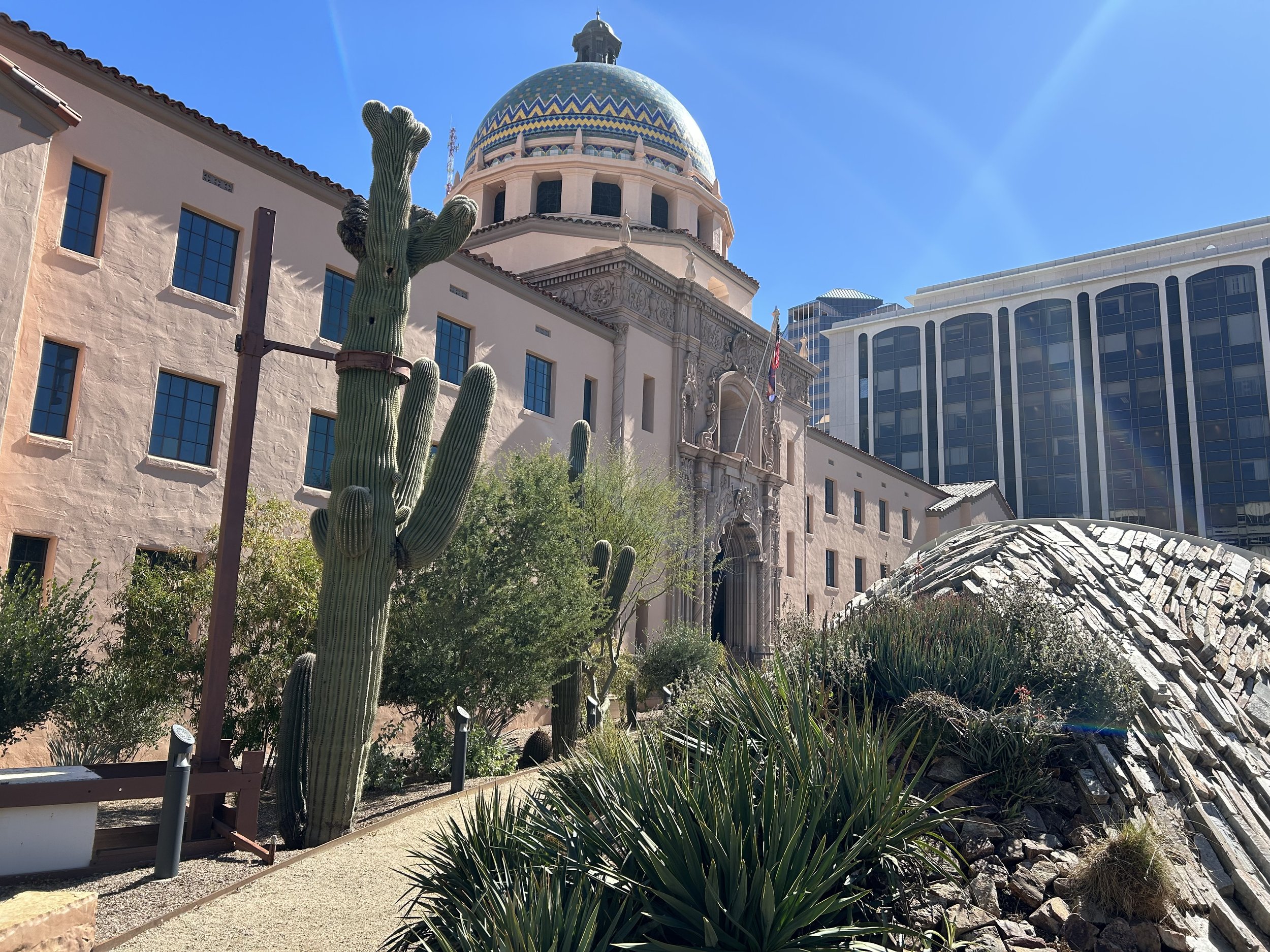Quick Guide to Visiting Tucson, AZ, in the Winter
Disclosure: post contains affiliate links.
Tucson is a city I can’t quit. Although not a native or a local, I lived there for a few months at one point in my life and have visited many times since. I’ve seen it in every season and I think winter might be my favorite. Cool enough for hiking comfortably but sunny enough to chase away my Pacific Northwest winter blues, Tucson is a perfect escape when you need your cactus fix. Come for the sun and stay for the art, museums, hiking trails, and restaurants. Here is everything you need to know about visiting Tucson, Arizona, in the winter.
Clouds cover Sabino Canyon in February
Tucson winter weather
The short answer? Tucson’s weather is usually excellent in the winter. Average high temperatures from November to January are around 70 F and it rarely rains. My last visit was during what the locals called the coldest and rainiest week they’d had all year. The highs were in the 50s and it rained a few times, lightly. Think drizzle and brief showers rather than the torrential monsoon rains of summer. Since I was visiting from Portland, OR, you can imagine I was not very sympathetic to this spell of “bad weather.”
Before I left Sabino Canyon, the skies were clearing
The most important thing to keep in mind when packing for a winter trip to Tucson are the day-to-night temperature swings. Although it’s often sunny and beautiful during the day, temperatures drop quickly as the sun goes down. It seldom gets below freezing, but expect overnight lows to be in the 30s or 40s. Bring layers and, just in case, a rain jacket.
How to find snow (if you want to)
I found snow on Mt Lemmon at about 6,000 feet of elevation
Tucson almost never gets snow in the winter, but the mountains surrounding the city are a different story. At a little over 9,000 feet, Mt Lemmon is the highest peak around Tucson and your best bet for finding snow nearby. As you drive up the mountain, you’ll notice the vegetation change from cactus forests full of towering saguaros to a high desert landscape not too different from the deserts I’m used to in Oregon. Palo verde and mesquite trees disappear, replaced by junipers, ponderosa pines, and hemlock. The higher you climb, the greater the chance of snow.
Windy Point on Mt Lemmon
Ski Valley near Mt Lemmon’s summit is the southernmost ski resort in the continental United States. The resort offers ski and snowboard rentals, a restaurant, and a fudge shop at 8,000 feet of elevation. Expect snow on Mt Lemmon starting from around late fall through spring.
Even if you aren’t skiing, the views from the Mt Lemmon Scenic Byway are worth the trip anytime during the year. The panoramas at Windy Point are among the best around Tucson. Parking is free at Windy Point, and restrooms are next to the parking lot. On your way there, you’ll pass some excellent hiking trails that start from the scenic byway. Most of them cost $8/day to park if you don’t have the America the Beautiful Pass. The Mt Lemmon Scenic Byway is usually open year-round but sometimes closes due to weather conditions.
Plants and animals
Roadrunner
One of the most surprising things for first-time visitors to Tucson is how green the desert is, especially in winter and spring. Even in the driest months, saguaros, prickly pears, barrel and pipe organ cacti, cholla, palo verdes, and greasewood bushes keep the landscape from looking barren. In a cold snap, you’ll see some cacti covered up with sheets to protect them from a freeze, a gesture I always find charming. After some rain, patches of green grass emerge.
Saguaro forests are impressive all year long
Winter isn’t the best time for seeing desert fruits and flowers. Many types of cacti will bloom in April, and glorious flower crowns appear on saguaros in May. You can find wildflowers on hillsides as early as March. Still, there are a few seasonal highlights to look for in winter, like cheerful yellow barrel cactus fruit and delicate purple flowers on rosemary bushes.
Depending on your preferences, the winter animal life around Tucson could be a bonus or a drawback. I love reptiles, including the biting ones, so winter hibernation has me missing the snakes, tortoises, and lizards. You might still see them on a warmer-than-usual winter day, say above 70F.
Besides reptiles, you can find plenty of wildlife in and around Tucson in the winter, like deer, javelina, coyotes, mountain lions, and over 500 bird species, including roadrunners, hummingbirds, songbirds, and raptors.
Roadrunner near Sabino Creek
Things to do in Tucson in the winter
Hiking
Bug Springs Trail on Mt Lemmon
Winter is an ideal time to go hiking around Tucson. Cooler temperatures keep unshaded trails comfortable, even on sunny days. Occasional cloud cover adds drama to the mountain ranges surrounding the city. Rain showers are possible, but you won’t have to worry about snow gear unless you head to high elevations. Here are a few of my favorite hiking spots near the city:
Sabino Canyon Recreation Area has some of the most rewarding hiking trails near Tucson. In all but the driest times of the year, Sabino Creek flows at the base of this impressive canyon in the heart of the Santa Catalina Mountains. High water levels are more likely in the winter, sometimes flooding the road into the canyon and blocking access to some of the hiking trails. To avoid wet feet, either wear high (above the ankle) waterproof boots or stick to trails that don’t require crossing the creek, like the short trek to the Sabino Dam. If you want to limit your hiking, try out the electric shuttle. Parking costs $8/day, or use the America the Beautiful Pass.
The hiking trails on Mt Lemmon have unforgettable views. As long you don’t get too high in elevation, you can usually avoid the snow. The Bug Springs Trail would be a good choice for winter. The full hike is long and may have some snow towards the end, but don’t worry if you want to turn around sooner. The scenery will still be spectacular. Parking is free at the Bug Springs Trailhead but some trails on Mt Lemmon require an $8 day-use fee or the America the Beautiful Pass.
Make the 1.7-mile paved loop around the top of Sentinel Peak, better known as A Mountain in honor of the University of Arizona’s giant letter A decorating its side. Although this popular urban trail won’t feel like the wilderness, it’s easy to reach and offers great views of the Tucson Valley. Parking is free whether you walk or drive up the mountain.
Take the Yetman Trail to the Bowen Homestead. This easy, family-friendly 2.3-mile out-and-back trail in the Tucson Mountains winds past giant saguaros on the way to the stone frame of a former family home. As a bonus, I saw, without exaggeration, at least twenty Gambel’s quails scurrying around the wash near the trail. Parking at the trailhead is free but there are no restrooms or amenities.
Rainwater lingers in the Bowen House after the skies cleared
Visit the Desert Museum
A rare crested saguaro grows outside the entrance to the Desert Museum. No one is quite sure why crested saguaros grow in a fan-like pattern at the top, although frost may play a role.
Don’t worry, I would never send you somewhere boring. Despite the underwhelming name, the Desert Museum is a fascinating exploration of all things related to the Sonoran Desert, especially its plants and animals. From the moment you reach the parking lot, you’ll be looking at a broad panorama of animal-filled desert landscapes backed by distant mountain peaks. Raptors fly freely over the museum’s many outdoor trails. My favorite exhibit is the hummingbird aviary, where dozens of pint-sized birds flit about, in no way intimidated by the human visitors. They will hover in front of your eyes, dive-bomb your face, and generally be the most delightful little punks.
The Arizona-Sonoran Desert Museum is about 25 minutes outside of downtown Tucson. Adult admission is $30.
Tour the Tucson Botanical Garden
You can find strange and wonderful cacti at the Tucson Botanical Garden
The Tucson Botanical Garden is the perfect place to admire the diversity of the local plant life without driving out of town to a national forest. Cacti of your wildest dreams line the elegant trails of the garden from tiny pincushion cacti to tall and venerable saguaros. My favorite plants there are the boojum trees, the absurdly conical-shaped members of the ocotillo family. Whether spiny, furry, or downright fantastical, the plants are all labeled to help you hone your identification skills. Plus, I suspect, to convince skeptics like me that some of the more fanciful ones are real.
While the plants are excellent, the highlight of the botanical garden is the Butterfly and Orchid Pavilion. Dozens of butterflies flutter around the pavilion, sometimes landing on one of the tropical plants or an unsuspecting visitor. The exhibit includes species from the Americas, Asia, and Africa, like flashy Blue Morphos, delicate Postmen, and giant Atlas moths.
Butterflies enjoy a fruit bowl in the Tucson Botanical Garden’s Butterfly and Orchid Pavilion
While you’re at the botanical garden, look for rotating art displays, a cafe, and a gift shop that includes gardening supplies. Adult admission costs $19.
Explore downtown
Southern Arizona Heritage and Visitor Center
Downtown Tucson is vibrant and thriving. Although a fairly small city, you’ll have no trouble finding things to do in the winter whether you’re into museums, music venues, or public art. Here are some highlights:
The Southern Arizona Heritage and Visitor Center stands out for its striking Spanish Colonial Revival-style architecture and incredible mosaic tile dome. Once the Pima County Courthouse, it now houses exhibits about local history, nature, and culture. Admission is free.
Catch live music or a comedy show at downtown venues like the Fox Theater and the Rialto.
Shop for souvenirs at Old Town Artisans.
Stop by the historic Hotel Congress, where authorities arrested John Dillinger. Besides a hotel, it’s also a restaurant, lounge, gallery space, and performance venue. If you need a place to stay, consider booking a standard or a haunted room. After a cursory search, it appears that the ghosts come at no extra charge.
Check out the Children’s Museum or the Tucson Museum of Art.
Enjoy the sculptures and murals. Dozens of murals decorate the area in and around downtown Tucson. Some are multiple stories high.
Food and drink
Fuel up for the day’s adventures with chilaquiles from La Chaiteria
Tucson’s restaurant scene alone is worth the trip. In 2015, the United Nations named it a City of Gastronomy, the first US city to receive this recognition. Although you can find just about any type of cuisine there, Tucson is celebrated for its signature Sonoran style that draws on Mexican and American influences. Expect simple, fresh ingredients and bold flavors. Here are some spots I like to help inspire your food and drink tour:
For brunch, try the flavorful Latin-inspired creations at La Chaiteria, including some great vegetarian and vegan options. As a lover of mole, I agree that it belongs both on my jackfruit enchiladas and in my latte.
For a mouthwatering slice of quiche or brioche French toast, head to the Cup Cafe inside the Hotel Congress. In the winter, portable heaters keep the patio seating cozy.
For dinner, try Boca's creative and delicious tacos, best enjoyed with a margarita.
For an excellent cup of coffee, go to Decibel Coffee.
For beer, check out the tap list at Tap and Bottle, which offers a little of everything. As a bonus, many people bring their dogs. On a mild winter night, it’s hard to beat the patio at Tap and Bottle’s sister location, Westbound.
For a lovely glass of wine in a chic yet laid-back setting, head to Revel.
Patio drinks at Westbound Tap and Bottle
Gems, minerals, and geology
Each year, Tucson hosts the Winter Gem and Mineral Show, the oldest and largest of its kind in the world. If you’re searching for obscure gems, minerals, or fossils, you can find them here. With displays ranging from meteorites to rare gemstones to petrified wood, I defy you to have an unmet rock need after visiting.
Beyond the showstoppers at the Gem Show, there is at least as much geology to admire in the mountain ranges framing the city: the Santa Catalina, Rincon, Santa Rita, and Tucson Mountains. Coming from Oregon, a land of young volcanoes and basalt-galore, I found the sheer variety of the rocks around Tucson mind-blowing. In the Tucson Mountains alone, you can find volcanic, sedimentary, and metamorphic rocks, with the oldest being around 1.7 billion years ago.
Gneiss boulders add beauty to Sabino Creek
One of the easiest places to appreciate Tucson’s geology is Sabino Canyon, where ancient granites combined millions of years ago to form gorgeous banded rocks called gneiss. Look for it in the steep canyon walls eroded by Sabino Creek, and in the fallen boulders that decorate the stream bed.
An easy hike leads to Sabino Dam and some beautiful rocks
Sunsets and stargazing
The sun sets in Tucson around 5:30-6 PM in the winter, making it easy to catch spectacular evening displays. Many cloudless twilights mean skies full of reds, oranges, and pinks. When the last rays of daylight hit the mountains, they turn a rich brick red. Sentinel Peak is one of the best places to watch the sunset in town. To the west, the parks near Gates Pass in the Tucson Mountains have glorious desert sunset vistas and feel more like the wilderness.
Sunset at Tucson Mountain Park near Gates Pass
After sunset, it’s worth taking a moment to admire the night sky. Tucson values starry skies and actively works to combat light pollution. LED streetlights angled downward help keep the stars visible even in an urban center. If you leave the city for stargazing, prepare to be wowed. It’s easy to see why Tucson is near major astronomical observatories. Dress warm, though. The desert nights get cold.
What to bring to Tucson in the winter
Relaxing at Windy Point
Water bottle. Even with cooler temperatures, the dryness of the desert will make you extra thirsty.
Bring layers, including lightweight shirts, sweaters, and a jacket. I brought my smaller down jacket, which was easy to pack and kept me warm during a cold snap. It’s one I wear all the time hiking in the Pacific Northwest. There is a similar jacket for men.
If you do any hiking, wear close-toed shoes to protect against cactus spines. Sneakers would be fine for many trails but hiking boots are better. I like these waterproof hiking boots for women and men.
Enjoy your winter visit to Tucson, Arizona!
With love,
Emma
Explore nearby
Visit the spectacular Sabino Canyon in Tucson.























